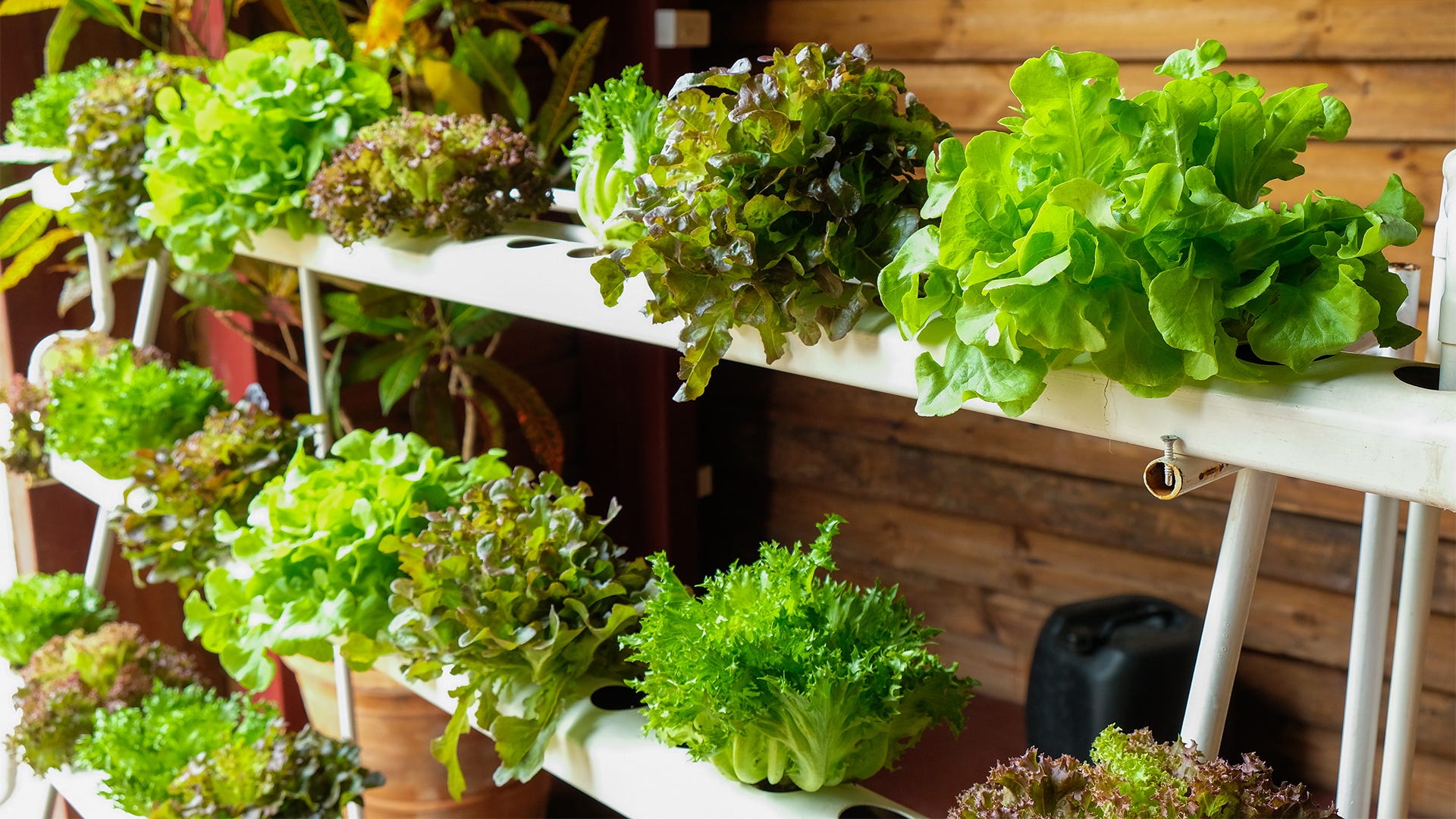
To start growing hydroponics, your grow room setup can be very simple and inexpensive, or you can outfit every detail to be as efficient and convenient as possible. The best part about this is that every singl decision from your lights to your growing medium is yours to make. Below we explain what you need to set up a grow room of your own, with options to take you from basic to fully outfitted. Soon enough you will be enjoying a successful grow room setup completely customized to your needs and tastes!
Bright Lights
Outdoor plants get the full spectrum of light, ultraviolet to infrared, from the sun. Inside, you need lights that mimic the sun’s range. Fluorescent and incandescent bulbs do not cover enough of the light spectrum to grow mature plants through to flowering. You need high-intensity discharge lights or a set of light-emitting diode (LED) fixtures.
Good: Metal halide lighting is strong in the blue range of the spectrum, the type of light that plants need for growing a robust canopy of branches and leaves. High-pressure sodium emits more light in the red end of the range, vital to vigorous blooming. LED lights are more expensive to purchase, but they don’t get as hot as the other types and are simpler to set up.
Best: You can successfully grow plants indoors with either type of lighting, but the ideal is to have both metal halide and high-pressure sodium and switch as the plant changes from its vegetative stage to the flowering stage.
Tip: Set up your light so that you can adjust either the height of your plants or the lights, allowing you to keep them a healthy distance apart—not too close together, not too far away—at each stage of growth.
Air Force
Fresh air brings vital oxygen and carbon dioxide to plants, and as it circulates, it reduces the risk of fungal diseases by keeping the humidity down (more on that in the next section). In an enclosed grow room, where the plants are respiring, you need to refresh as well as circulate the air.
Good: Simple fans you have around the house can gently circulate air. But to take out stale air and bring in fresh, you need extractor fans to pull out air and a vent or two to allow fresh air in.
Best: Carbon dioxide is so vital to photosynthesis that enriching the natural supply can promote extraordinary plant growth. You can pump CO2 into your grow room from a tank with a regulator or from an electronic generator designed for this purpose.
Tip: Setting up a fan to blow air gently on plants not only refreshes the CO2 around them, their stems grow stronger in steady breeze.
Humidity Hold
A room where liquid nutrient solution is continually dripped, misted, or soaked onto plants is bound to be humid. When humidity is too high, plants become hospitable to mold and other fungi that can ruin your crop.
Good: Air circulation is key for dispersing humidity that accumulates around the plants. Sacks of inexpensive silica gel also absorb moisture from the air.
Best: A dehumidifier lets you swiftly reduce the moisture in the room. Use a hygrometer to measure the humidity—50 percent is ideal for growing healthy, productive plants.
Tip: Be sure to keep the reservoirs for your nutrient solution covered at all times so that the liquid does not evaporate and contribute to the room’s humidity levels.
Wall and Floors
The right surfaces in your grow room can help your efforts. Reflective walls increase the light that reaches the plant. Carpeting can trap moisture and create conditions that are hospitable to fungus.
Good: Flat white paint can reflect as much as 85 percent of the light that hits it. Look for the light reflectance value (LRV) ratings on cans of paint. A concrete, linoleum, or tile floor does not hold moisture, like a rug does.
Best: Mylar sends back more than 90 percent of light—you can mount panels of it on the walls and ceiling. Covering the floor with a pond liner or another rubber sheet repels water. Cork flooring is expensive, but it is naturally resistant to fungi and fire.
Tip: Block windows and other sources of ambient light that can disrupt your plants’ dark period and its reproductive cycle.
Remember: Grow rooms are filled with lights, fans, pumps, and other items with a powerful demand for electricity. If you don’t have experience with wiring high-load outlets, get someone who does to assist you. An electrical fire in your grow room will ruin more than your crop.
Thermo Control
Plants grow best indoors in temperatures from 65 to 75 degrees Fahrenheit. Cooler temps slow growth; warmer temps stress the plants and leave them vulnerable to disease. The good news is that the ideal temperature range is similar to most homes. High-intensity lighting, however, is quite hot and can raise the temperature in your grow room.
Good: Fresh, circulating air can prevent heat buildup from the lamps. A grow room with a ceiling that’s taller than 6 feet leaves space above lamps for some heat to dissipate.
Best: An independent heating and cooling system for your grow room gives you total control of the temperature at all times, allowing you to turn it down when the lights are on and up when they are off.
Tip: For consistent, healthy growth, keep the temperature as close to even as possible between the light and dark periods.
Want to Share Your Experiences?
We love seeing your posts on our Facebook page. Whether you share your garden setups, recent harvests, or have questions about pests invading your crops, we want to hear about them and share our expertise. Our learning center is another great resource that will help answer or guide you through difficult gardening or lawn care situations. To stay up to date on our products, exclusive offers, or new articles, sign up for our e-newsletter.



